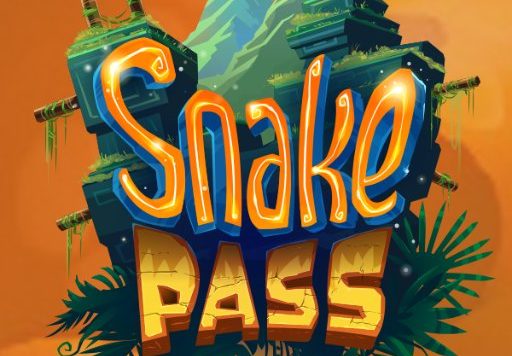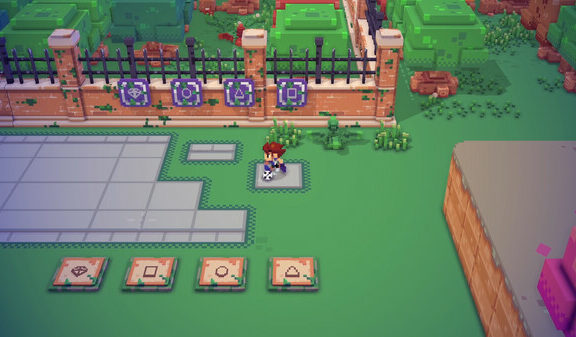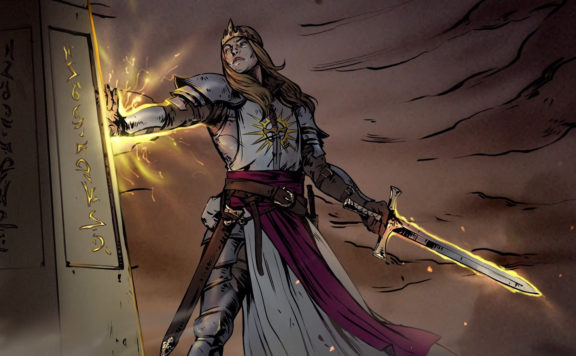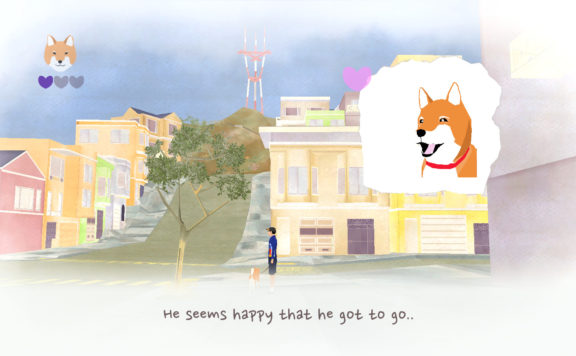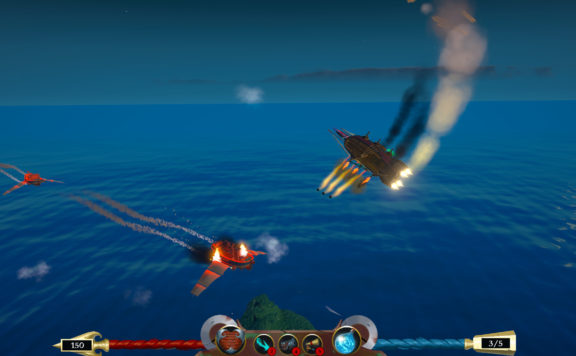Before we can dive into our review of Neversong, we need to talk.
What you are about to read is one part review with a dash of history and a hefty shake of exposition on topics of the title. I give you that warning because there are parts of this game that we can’t talk without getting into heavy topics like death, loss, and trauma. If you are not here for that, I understand – this is a video game review, after all. I will do my best to separate to two so that you can explore either (or both) as you wish.
Once Upon a… History
Neversong comes to us from the team at AtmosGames owner and art director Thomas Brush. Back in 2010, Brush created a game call Coma and uploaded it to Flash-based creation repository, Newgrounds. Coma was an exploration of the subconscious that was a short, but very well received work. With over 2.5 million plays, it garnered its creator a measure of notoriety for it, fueling his passion to create the 2017 smash hit Pinstripe. But in this success, the echoes of Coma’s impact still lingered in the air.
In 2018, Brush launched a Kickstarter campaign to reimagine the title under the name Once Upon a Coma, continuing the legacy of the Flash title by fanning the flames of creativity once more. The community responded and the campaign tripled Brush’s goal of $28,000. After some consultation between AtmosGames and partner Serenity Forge, the name was changed to Neversong to better fit the theming of the game while retaining its connections to the world of Coma.
Neversong would release on the Apple Arcade in early May with console and Steam releases following shortly thereafter.
Examining Neversong’s Sheet Music
Neversong is set in the 1960s. It is a haunting tale of an orphan boy named Peet whose live is riddled with tragedy and loss. During a day of misadventure, Peet and his girlfriend, Wren, wander into a local asylum. Wren is kidnapped by the ravenous maw of the asylum’s resident physician, Dr. Smile! In the dizzying madness of the situation, Peet descends into a fear-induced coma. He wakes three weeks later to find that Wren is still missing and all of the adults in his small town have disappeared as well. What began to look like a utopian new age for the children of Redwind Village quickly turns into something a little more sinister as the adult have all been turned into monsters or have been driven into a murderous insanity.
This mixture of whimsy and the macabre seeps into every corner of Neversong’s world. The art style is what I picture a Tim Burton reimagining Bill Watterson’s Calvin and Hobbes series would look like. It is a world mixed tones – it is hazy and muted with some places that have restrictive darkness. Yet, it is filled with character designs that are both warm and foreboding at the same time. This caries into the sound design as well. There are hauntingly beautiful moments captured in the soundscape that accompany those that are just plain unsettling – especially in those moments when Dr. Smile is near! Brush and his team nail the tone that they aimed to set, building a world that’s siren song invites you into the madness.

The gameplay of Neversong is a few parts platforming and puzzling with a healthy dash of Metroidvania. It follows genre pretty closely – the “rinse, lather, repeat” of explore, discover power-up, unlock puzzles with said power-up, defeat boss, and advance the story. The difference, however, in Neversong is the way that you discover these new “power-ups” and what they represent. Each item is something precious to Wren that she has locked away in her room – such as her favorite baseball bat and skateboard. These special positions have been locked away in spaces that are only accessible to Peet as he rediscovers the music they once made together – the sweet melodies of their song, the Neversong! When Peet plays these pieces on Wren’s piano, the world opens up just a little bit more to him, bringing him that much closer to his beloved.
As you explore new places, the story unfolds at a well-timed paced. While there is some backtracking (as there is with any game that comes close to a Metroidvania), it never felt too cumbersome or that the five regions of the world were stretched out too far. While there are plenty of extra puzzles and collectibles that will keep you in Peet’s world for some time, my total time with the story was around 4 hours.
The controls for Neversong are pretty straight forward, although, they do require a little trial and error to figure out. It can be played with either a keyboard or controller, but between the two, we would recommend a controller. It just feels more natural for this type of game – especially when platforming!

We did run into a few moments during our playthrough where we got stuck between level sections. This was largely due to me throwing Peet over the normal transition points, because… parkour. These moments put Peet outside of the play space and even removed some of the visual filters off the screen. These situations were not game-breaking; they were fairly easy to back out of and I never had to reload from a save location to get back into the game.
Without giving any spoilers, Neversong weaves together engaging gameplay and heavy, but worthwhile themes with aesthetics that are just as much a part of the story as the characters the game introduces to us. If you like platforming puzzlers with elements of atmospheric and thematic horror, Neversong may just be music to your ears! And if that’s you, the even better news is that it will be launching with a 15% discount on Steam!
Playing in Somber Keys: Digging Into the Themes of Neversong:
As I shared in the opening, it is nearly impossible to talk about Neversong without diving into the heavy topics that it covers, specifically those dealing the impact of death, loss, and trauma. While I am not a professional counselor, as a pastor, I am in a position to refer people to them… and I encounter these three more often than I can recount.
Death is without discrimination. It does not care if you are rich or poor, young or old, what your ethnicity, religion, or political persuasion is… it only knows its own hunger. Death feasts without consideration, leaving behind vacancies once filled by loved ones. It takes and takes, never satisfied… and just how it takes can leave us in different places. By that, of course, I am talking about trauma experienced in loss. What I appreciate so much about the experience that the AtmosGames and Serenity Forge teams deliver is that it encapsulate the ravenous nature of death and the ripple effects of traumatic loss.
While it can manifest in different ways, trauma can be a time lock, sealing away specific moments, stages of life, or ideals only to resurface with the right stimuli. It can be a twisted, hellish form of nostalgia that colors everything we see and experience – people, places, emotions, feelings – everything. At any moment, something can signal a reminder of the events, causing the walls to close in on us just a little bit tighter.

Every moment Peet gets near to Wren, Dr. Smile is not far off, leaving Peet to blackout and wake up elsewhere. He has experienced a grievous loss and fear-induced coma, there is a sense of regression. When Peet wakes up, Redwind Village is nearly perfect – almost too idyllic. There are no adults, only his friends. Everyone seems jovial in their newfound situation. However, the adults he does encounter have murderous motivations or appear monstrous. When we are introduced to him at the beginning, we are told that Peet was an orphan. The implications of adults as monsters or murderous are numerous, but it makes sense for the story.
Dr. Smile is an incredible representation of death; he is often seen as gaunt and gasping for his next meal. While death does not care what the source is, there are even moments when we see Dr. Smile attempting to reason with Peet that only what is dearest to him, Wren, can satisfy his hunger. We often
In all of this, AtmosGames and Serenity Forge do not use these as throwaway story devices but treats them as a meaningful parts of the experience in order to understand them better. The journey of Neversong illuminating another side of death, trauma, and loss that we might see a bit more clearly. For what purpose? Freedom in truth.
 Diving into any heavy topic can be unsettling, but perspective can be a powerful thing. While understanding may not remove the pain of loss or the full extent of trauma, it can help us get beyond what we feel to acknowledge why those events made us feel what we do. Identifying the “why” can help us to choose what’s next, but it all starts with taking that first difficult step toward understanding.
Diving into any heavy topic can be unsettling, but perspective can be a powerful thing. While understanding may not remove the pain of loss or the full extent of trauma, it can help us get beyond what we feel to acknowledge why those events made us feel what we do. Identifying the “why” can help us to choose what’s next, but it all starts with taking that first difficult step toward understanding.
Art like this challenges us to do something with the information that we have or that we have gained from our encounter with it. I would encourage you, if you are experiencing the fallout from trauma or have experienced traumatic loss, reach out to a professional and talk to them – whether it is seeking out a counselor or finding yourself sitting across a room from me.
Note: Our copy was reviewed on Steam with a code provided by PR.
COMPARE TO: Hollow Knight, Pinstripe, The Swapper


